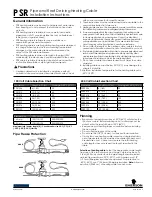
SAFETY
WARNING FOR INCORRECT OPERATION OR ACTION THAT
COULD HAVE PHYSICAL INJURY OR DAMAGE TO THE
EQUIPMENT AS A RESULT.
SAFETY INSTRUCTIONS
+
Never use this magnet before these instructions have been
read and understood
+
Persons fitted with a pacemaker or other medical equipment
should never use the magnet without first consulting
medical specialist
+
Never remove warning or instruction plates from the
magnet
+
Always wear safety glasses, gloves, protective footwear
and a helmet
+
Never stand or move under the load
+
Never transport over or past people
+
Never use the magnet as an aid to lifting, supporting or
transporting persons.
+
Warn bystanders when beginning to lift and load
+
To prevent the hook from slipping out of the eye hook
always use a lifting hook equipped with a safety latch
+
Ensure that the weight and dimensions of the load to be
lifted do not exceed the maximum permitted values
+
Never use a damaged or poorly operating magnet
+
Only switch the magnet on when it has been placed placed
on the load
+
Only switch the magnet off when the load has been placed
on a stable surface
+
Never lift more than one workpiece at a time with this
magnet
+
Never leave a hoisted load unattended
+
The temperature of the load or the surroundings must
never exceed 8o°C
+
NEOHOT - The temperature of the load or the surroundings
must never exceed 180°C
THE WORKLOAD LIMIT MAY BECOME LESS AS A RESULT OF
+
Air gaps between the load and the magnet, caused by paper,
dirt, paint, burrs, damage, surface roughness etc. either on
the load or the magnet.
+
Thin loads. The thinner the load the less the lifting capacity.
+
Lenght and width of the load. Long, wide parts that hang
outside the magnet protrusions, resulting in an air gap. This
is called the peeling effect.
NEVER EXCEED THE MAXIMUM WEIGHT AND/OR DIMENSI-
ONS FOR THE MATERIAL THICKNESS STATED IN THE TABLE.
NEVER PLACE THE MAGNET OVER A LARGE HOLE OR BORE.
+
The load material type. In general it applies that: high alloy
percentage = low lifting capacity. Some alloys are even
totally non-magnetic (e.g. stainless steel 304).
+
A small contact surface between pole shoes and load. In
case the load does not fully cover the pole shoes the lifting
capacity will be reduced by the same percentage.
THE VALUES IN THE TABLE ON PAGE 4 APPLY TO ST. 37 (S 235 JR). FOR OTHER MATERIALS THE LIFTING CAPACITY WILL
REDUCE BY THE PERCENTAGES BELOW:
A WORKPIECE SHOULD COVER BOTH POLE SHOES AS FAR
AS POSSIBLE, AND ALWAYS TO AN EQUAL AMOUNT.
+
The magnet must remain fully horizontal during transport.
UNSAFE APPLICATIONS
1.
Never lift more workpieces simultaneously
(e.g. thin sheets)
2.
Never lift a load on the smallest side
3.
Never place the magnet with the long side lengthwise on a
flexible workpiece (peeling efect)
Material
%
150
300
600
1000
1500
2000
S 235
100
150
300
600
1000
1500
2000
St 52
96
144
288
576
960
1440
1920
Cast steel
90
135
270
540
900
1350
1800
Stainless steel
50
75
150
300
500
750
1000
Cast iron
45
67
135
270
450
675
900
Nickel
10
15
30
60
100
150
200
For other materials consult your supplier.
EN
1.
2.
3.








































